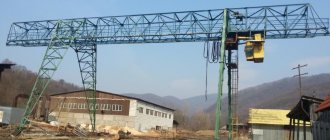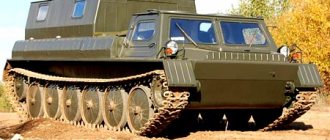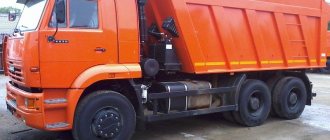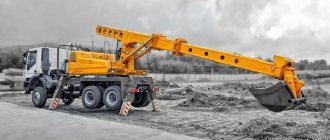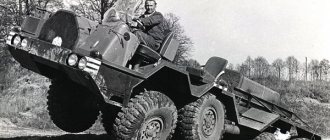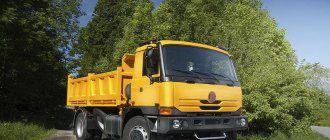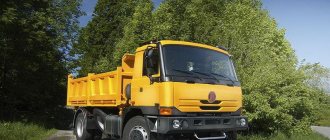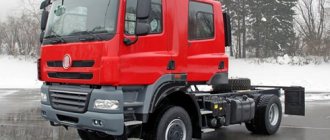Indestructible "Tatra"
Mikhail Sokolov, Sergey Andreev Photos of the authors, from the authors’ archives and from the Internet resource rcforum.ru
Of the models of bonneted trucks of the Czech company, this one became the most famous, popular and widespread in the USSR in the era of developed socialism*. Even now, on our roads, no, no, and indeed we come across such uncharacteristic for us at first glance, but painfully familiar outlines of the latest examples of the glorious T-148 tribe.
* About the earlier Tatra trucks that came to the USSR: A bright trace of the One Hundred and Elevenths. "One hundred thirty-eighth" in the Soviet open spaces
About the history of the model. Modification "T2-148"
Czechoslovakian Tatra (in the early 20th century - Kopřivnická Vozka) is one of the world's three oldest car manufacturers still in business. The headquarters and parent company of the company are located in the city of Kopřivnice, in the Moravian-Silesian region of Czechoslovakia. The machine-building enterprise has been operating since 1850, and produced its first car, Tatra, in 1897.
The Tatra-148 dump truck was a further development of the Tatra-138 . The modernization of the 138th “bonnet” Tatra began in 1967. The first prototypes of the 148th model appeared in 1968, and a year later they were officially presented.
"Tatra-148" has the same cabin and wings as its predecessor. However, it has a different hood, with a wider front section to increase air flow. In accordance with the hood, the bumper also “grew” forward. The flanges of the axle shafts became round instead of hexagonal ones, and the number of studs attaching the axle shafts to the hubs increased from 6 to 10.
Even more changes were made inside the car. First of all, the Tatra T2-928-1 engine has been significantly modernized. The increased displacement provided an increase in power by 32 horsepower and brought this figure to 212 hp. At the same time, the level of noise, vibration and harmful engine emissions into the atmosphere has decreased. The speed of the car has also increased. The driver's cabin, although it remained the same, was equipped with better sound insulation and an overall level of comfort.
In 1969–1971, Tatra-148 trucks began to be produced in parallel with the T-138, and during this time 577 units were produced. In 1972, Tatra-148 finally replaced the previous model on the factory assembly line.
This dump truck underwent serious modernization in 1979. More than eighty changes were made to its design, many of which were based on an analysis of operating experience in the harsh conditions of Siberia, the Far East, and the Far North. In the process of this modernization, diesel fuel consumption was reduced; noise level in the cabin has been reduced; Stable engine starting was ensured at 20-degree frosts; air cleaners with an oil bath and a new generator were introduced. The driver's seat has air suspension.
The front axle was equipped with improved universal joints and double hub seals. Torsion bars made of new material, with a different type of fastening, have significantly increased the degree of reliability and durability of this unit, which is subjected to significant loads.
Instead of two hydraulic cylinders of the lift, they began to install one, of increased diameter, with more durable cuffs and ball joints. “Tatra T2-148” (factory index after modernization in 1979) was equipped with a new body with a useful volume of 9 cubic meters, with sides made of new stamped metal, with a frame of greater rigidity. Externally, T2 cars began to be distinguished by a changed configuration of the holes in the hood lining.
Every year, Tatra-148 production volumes increased at a tremendous pace. Thus, according to the CMEA decision, the enterprise was allocated funds to reconstruct and increase the annual production of Tatra trucks to 15 thousand units (which was more than twice the current capabilities of the plant). Thanks to this, on January 8, 1982, the production of the 100,000th Tatra 148 car was celebrated in Kopřivnice. The same year was the last in the era of hooded Czechoslovak trucks: on December 14, 1982, the last, 113,647th Tatra T2-148 rolled off the assembly line, giving way to the new hoodless Tatra-815.
The versatility, reliability, and high cross-country ability of this model have been repeatedly confirmed by operation in harsh natural and climatic conditions - in the development of oil and gas fields, the construction of large power plants (including nuclear power plants), roads and railways. "Tatra-148", along with "Magirus-Deutz" , "IFA W50" , became one of the few imported truck models that were massively supplied to the Soviet Union and showed their best performance here.
Release history
The creation of the Tatra 148 model, a photo of which can be seen below, began in the form of its first prototypes back in 1968. And only a year after that the car was officially presented to consumers. In appearance, the model was very similar to the previous version - the 138th. But at the same time, the hood had a wider front part of the cabin, which increased the level of air flow necessary to cool the power plant. The flanges of the axle shafts began to be made in a round shape, although in the previous model they were hexagonal, the number of studs with which they are attached directly to the hubs increased to 10 units.
The Tatra car has several modifications. During the period 69-71, the first small-scale production began, which was carried out together with the 138th model.
During this time, only 577 units were collected. Full-fledged conveyor production began only in 1972. After 7 years of large-scale production of the model, the plant modernized this car, making about 80 changes to it. Thus, fuel consumption was reduced, the noise level in the cabin became lower, and it was also possible to start the car even at a temperature of -20 degrees.
Options for the Tatra-148 truck
The basic modifications are dump trucks S1 (with rear unloading) and S3 (with three-sided unloading). The main version is S3. In the first years of production, dump trucks were equipped with bodies with a geometric capacity of 8 cubic meters, and on the S3 the side walls were made of two halves, vertically divided and suspended on upper hinges.
The extended body on the Tatra-148/S3 did not leave room for a spare wheel, so it was placed under the platform, on the frame, in an inclined position. The hydraulic system tank and tool box were also moved there.
Already in the early 70s, with the start of mass production, Tatra-148 dump trucks acquired new bodies: for S1 - increased to 9 m3, and for S3 - the same volume, but with horizontally divided side walls (one half was mounted on the upper hinges , and the other on the lower ones). During lateral unloading, the lower part of the side, restrained by two chains, was a continuation of the platform, greatly reducing spillage of cargo under the wheels.
In 1977, tool boxes were no longer installed on the S3, and in 1980, the S1 was no longer equipped with them. Less common, and even exotic, options were the Tatra-148 flatbed truck, as well as two- and three-axle tractors (NT 4x4 and NT 6x6). Tankers for various purposes, fire engines, concrete mixers, hydronators, pumping stations, etc. were also produced on the Tatra-148 chassis. special vehicles.
Several variants of truck cranes on the Tatra-148 chassis became successful design solutions: “AD-20”, “AD-070”, “AD-160”. They had a great degree of versatility and could be used anywhere. In particular, in the construction of small buildings – where using a tower crane would be impractical.
Excavator-planner “UDS-110” “golden handle”.
The excavator-planner on the Tatra-148 chassis (models UDS-031, UDS-032, UDS-110, UDS-113) received great popularity and general recognition. For its unique precision of work and advanced capabilities, it was called nothing less than the “golden pen”. The boom of this excavator had a telescopic design; the rotator provided operation with both a forward and a backhoe. A hook was prudently welded onto the bucket, which made it possible to use the “golden handle” as a truck crane.
Other professions "Tatry"
In addition to dump trucks, other types came from Czechoslovakia: flatbed trucks, truck tractors, concrete mixers, pumping stations, truck cranes, etc. The UDS-110 (and UDS-113) excavator-planner became the most popular. For its unique capabilities it was called nothing less than the “golden pen”.
But even in the USSR, vehicles for local conditions were often created on the T148 chassis - metal carriers, timber carriers, tank trucks, carriers of tracked vehicles...
The Khrustalnensky Mining and Processing Plant (Primorsky Territory) had about a hundred “148s”. And here, some of them were converted into tanks for delivering fuel oil and diesel fuel to remote mines. High-capacity trailers were made for them from decommissioned T138s, but the local traffic police, for safety reasons, subsequently banned their operation (the area was replete with large slopes, which became impassable after snowfalls). Subsequently, the tank trucks were operated with trailers of the MAZ-8926 type with tanks on their platforms, after dismantling the tailgate and the adjacent side ones. Several T148 airborne vehicles received in 1980 were also converted into tank trucks. When the UTVA-TsPP-24 semi-trailers arrived, two Tatra 148S1 dump trucks were converted into truck tractors, but were later replaced by factory tractors. Unclaimed in one of the military units of Primorye, the Tatra 148NT “saddlers” were transferred to the mining and processing plant, where they were repainted blue, and for many years they worked properly at the enterprise.
Design Features
The main feature of the Tatra-148, like other trucks of the Czechoslovak manufacturer, is the spinal frame of a unique design. The machine is based on a transmission pipe-ridge, inside of which there is a thin shaft (replacing the cardan shaft), and to which the engine and gearbox are attached using a special half-frame. This original design allows the installation of split axles with independent suspension, which gives an incredibly large range of movement of the axle shafts in the vertical plane.
The spinal tube is made of spring steel, has enormous bending strength and torsional rigidity, which makes the superstructure and subframe lighter, and also allows the car to be loaded “with a significant advantage” (which was willingly done in the USSR all the years).
This design makes it possible to make any wheelbase size and any number of axles. You can choose the wheel formula 4x4, 6x6, and so on, up to 12x12. The disadvantage of this design is its high cost compared to a conventional “ladder” frame. And, if under socialism Tatra had the ability to produce up to 15 thousand trucks a year, today, given their price, these vehicles have turned into “piece goods” for wealthy oil workers.
The front suspension "Tatra-148" is a torsion bar, and the rear is made on longitudinal semi-elliptic springs. The detachable housings of the drive axles migrated from the Tatra-813 design. The drive to the rear axles was supplemented with a center differential.
70s. Caravan "Tatr-148" in the Magadan region.
The center differential on the Tatra-148, like classic cross-axle differentials, was equipped with forced electro-pneumatic locking, but had separate on and off buttons. And to control the locking of cross-axle differentials, you had to constantly hold down one single button. After the modernization of 1979, the swing axle shafts of the bridges were significantly strengthened, so in actual operation the number of their breakdowns (which occurred in the 138s, which usually worked with overloads) was reduced to almost zero.
The second main feature of the design is that the diesel engine is not liquid-cooled, but air-cooled. Despite significant power and high torque!
Second life of a soldier
The long and remarkable history of the Tatra company and its famous cars deserves a separate and detailed discussion, to which we will definitely return. However, this time we want to talk about one rather rare Tatra truck from the 138th family.
Tatra trucks of the 138 series were produced from 1959 to 1972, replacing the legendary Tatra 111 (1942-1962) on the assembly line. The model range included about one and a half dozen versions: dump trucks, chassis, tractors and trucks with flatbed platforms. About 5.5 thousand “one hundred and thirty-eighths” were delivered to Russia, most of which were dump trucks. Alas, today only a few of these thousands are “alive”, and this is not at all a matter of how long ago the years were: many of these unique cars were mercilessly cut into scrap metal, and no less a number of “Czech” cars were written off and simply abandoned to rot and plunder. But there are still enthusiasts in Russia who find “dying” Tatras and give them a second life.
...The military modification of the Tatra 138 VN, extremely rare in Russia, released in 1965, was received by its “reanimators” far from in ceremonial form: peeling paint, a dilapidated wooden side platform, the entire mechanical part covered in dirt and oil... But, despite the unpresentable appearance, the car, most importantly, was not damaged, the “tin” turned out to be in good condition (this is after almost 40 years!), so it made sense to try to restore it all to a presentable form. There was no shortage of enthusiasm, and work began to boil.
The car was carefully sanded off of the old paint, the side body was restored and the whole thing was painted again, but in a different color. We also had to weld some slightly rusted thresholds here and there. It must be said that in the process of “reanimation” Tatra parted with not only its original color. Externally, the original military version, in addition to the protective khaki color, was distinguished by several other elements. Firstly, there is a large sunroof. Secondly, the wipers were installed above the windshield and had an emergency manual drive in case the electric motors failed. Thirdly, the turn signals on the cab and wings were round in shape, and the front bumper was a simple angular channel with brackets for installing adjustable sidebars. So, during the restoration of the truck, the owners cut out the hatch, moved the wipers under the windshield, adapting electric motors from the Tatra 148 to them, and replaced the simple round turn signals with oval ones from civilian models. The bumper has also been redesigned, making it more rounded and civilized.
The salon has been completely transformed almost beyond recognition! The first thing that catches your eye is the leatherette-trimmed seats (original), the rear wall, the doors and pillars of the cabin, the ceiling and the front panel. Then, looking closer, you notice wooden inserts on the doors, instrument panel and gearshift lever. Hmmm, there was nothing even close to the smell of anything like that in the military version; all around there was just bare painted metal. And here are such “bourgeois luxuries”! On the other hand, the current owners made this car for the soul, and not for combat operations behind potential enemy lines. In addition, upholstery of the interior with soft material is not only aesthetically pleasing, but also provides additional sound and heat insulation.
Now let's look under the hood. For the entire 138th family of Tatra trucks, one engine was offered - an atmospheric 180-horsepower diesel “eight” T-928 air-cooled. The engine on the restored truck was in very good condition and did not require extensive restoration work. They just cleaned it of dirt and old paint, washed the lubrication system, repainted it, rebuilt the injectors and installed a domestic generator, since it was not possible to find a replacement for the burnt-out charging relay on the “native” generator. And so far the motor is running without any problems. True, soon, apparently, some gaskets will need to be changed, otherwise the engine is slowly “sweating” oil. Age, you can't escape...
When mentioning air cooling, someone may immediately have unkind associations with the Zaporozhets, or more precisely, with its “air” engine, which had a chronic tendency to overheat. The idea that such a motor is a complete torment and the lot of only such a “miracle of technology” as the “Zaporozhets” is firmly ingrained in the head of our compatriot! But this is not so, it’s not for nothing that Tatra still produces “air blowers” that have a number of advantages over traditional engines. And anyone who has dealt with Tatra will say that a better engine cannot be invented. Refusal of the water cooling system allows us to seriously simplify and lighten the engine, as well as increase its reliability and maintainability. An air-cooled engine is especially suitable for work in northern regions, since starting and warming it up in bitter cold is much easier than a water-cooled engine.
A powerful fan is responsible for cooling the engine, which circulates air between the heavily finned, motorcycle-style cylinders and cylinder heads. On previous Tatra 111s with 12-cylinder diesel engines, the fans (there were two of them) were belt driven, but on the 138 series trucks, a fluid coupling appeared in the fan drive, which ensures a fan rotation speed that is several times higher than the engine rotation speed. In addition, the fluid coupling simultaneously works as a damper, absorbing shock loads on the fan during a sharp change in engine speed. But the main thing is that with proper engine adjustment and competent driving technique, engine overheating is an exceptional phenomenon, even if the truck is operating in tropical heat.
The engine lubrication system is circulating, under pressure, with a so-called “dry” sump. This system ensures reliable lubrication of parts even at an inclination of 40° in the longitudinal direction and 30° in the transverse direction. So, when storming slopes, the engine is not in danger of oil starvation.
Tatra engines have always pleasantly surprised drivers and mechanics with their high maintainability, and this case is no exception. For example, the engine cylinders are made according to a separate (!) scheme. So in case of “inoperable” damage, it is not the entire expensive block that needs to be replaced, but only one cylinder - just unscrew a few pins! The engine crankshaft is also made dismountable: if the connecting rod journal is seriously damaged or it can no longer be ground to a new size, it is simply unscrewed and replaced with a new one. Compare with replacing the entire crankshaft! By the way, the crankshaft main journals are mounted on roller (!) bearings, which also extends the service life of the crankshaft and simplifies repairs. It is also worth noting how seriously the Tatra 138 VN is prepared for winter operating conditions. A powerful dry-type autonomous heater is installed behind the cabin, which can simultaneously supply warm air not only to the cabin, but also to the body! So that, you know, the soldiers sitting in the tented body don’t freeze. In addition, the “autonomy” can also work as an engine preheater. Using pipelines, it supplies hot air directly to the engine compartment, heating the cylinder block. In addition to the cylinders, the oil tank and engine air manifolds can be additionally heated. And as a last resort, the air manifolds have channels for injecting ether! After such a “systematic approach,” the engine will definitely start, even if the truck has been standing at the North Pole for a week and is, as they say, frozen to the bone. It must be said that the plant did not offer such a “winter package” in the basic configuration for civilian versions. Well, the car in front of us is a military one. And a military vehicle, like a pioneer, must be “always ready”...
No less remarkable is the truck chassis itself, folded according to the famous “Tatrovsk” scheme, which is already more than 80 years old. The basis of the truck is a powerful backbone frame in the form of a hollow pipe. The main advantage of such a frame is its enormous bending and torsional rigidity, while bodies or equipment mounted on a separate subframe are reliably isolated from deformation forces. Therefore, even a loaded vehicle can easily move along continuous gullies with constant diagonal hangings without the risk of bending or breaking the frame and body, as can happen on trucks with a traditional frame. By the way, thanks to the rigidity of the spine tube, Tatra is probably the only truck in the world that can drive without one front wheel!
Engine torque is transmitted to the main 5-speed manual transmission. The box itself is located in the center of the car above the “spine” of the frame, so it is easy to get to it for repair or dismantling. The main gearbox is interlocked with a 2-speed additional gearbox (multiplier), thanks to which the driver always has 10 gears at his disposal: 5 high and 5 low, plus two reverse gears. The most interesting thing is that the control of the additional box is electro-pneumatic! And to switch from higher gear rows to lower ones and vice versa, just switch the flag on the gearshift lever. Connecting the front drive axle and blocking the cross-axle differentials is also done using electro-pneumatics - just press a few buttons on the instrument panel. Very comfortably! Nowadays, electro-pneumatic transmission control will not surprise anyone, but imagine how it looked then, in the 60s!
From the additional gearbox, torque is transmitted to the drive axles using transmission shafts passing inside the supporting frame pipe. On the one hand, in this case it is more difficult to get to the shafts during repairs, but these shafts are reliably protected from dirt and damage. Another characteristic feature of the Tatra chassis is split axles with swing axles. To ensure the swing of these axle shafts and do without complex universal joints and joints, the designers acted simply: they equipped each axle shaft with its own main gear, consisting of a separate disc and bevel gear. (This is why the axle shafts of the right and left sides are offset relative to each other by several centimeters along the pipe). Swinging axle shafts provide the wheels with enormous travel up and down, so even in very rough terrain the tires reliably maintain contact with the ground.
All-wheel drive, locked cross-axle differentials on all three axles, high ground clearance, long-travel independent suspensions - all this gives the Tatra truly tank-like cross-country ability.
To “plant” a car, you have to try really hard. But if it does happen, a mechanical winch located at the back under the body, which is included in the standard equipment of military modifications of Tatra trucks, will come to the rescue. The winch itself is driven by an additional gearbox, so the force generated is enough to pull even a heavily loaded vehicle out of any “ambush” without much strain. The main thing is that the cable does not break and the tree gets thicker. What if the truck needs to be pulled forward rather than backward? This has also been thought out: there are several pulleys on the frame through which the cable is passed and brought forward! Yes, with such a solid off-road “weapon”, there are almost no impassable places on the planet’s map for the Tatra 138 VN... Here we will stop our story. You can, of course, describe this car, its design and driving performance for a long time, and you still won’t be able to say everything. It’s better to see, hear and touch it all once for yourself. How? Come to the Autoexotica festival (July 9-11) in Tushino - you’ll see everything. Share
Engine "Tatra-418"
Only the Tatras, and even an active participant in the construction of the BAM, the Magirus-Deutz dump truck, of all the serial heavy trucks in the world, were equipped with powerful diesel engines without a liquid cooling system. In severe frost conditions this became a significant advantage.
The Tatra-148 truck was equipped with an eight-cylinder diesel engine “T 2-928-1”, the power of which is 203 horsepower at a rotation speed of 2000 rpm. The arrangement of the cylinders is V-shaped, at an angle of 90 degrees relative to each other. The working volume of the power unit is 12.667 liters. The maximum torque reaches 810 N*m, at a rotation speed of 1200 rpm. The engine was air-cooled with a multi-blade turbine.
The fuel tank capacity was 500 liters. The average diesel fuel consumption was in the range of 30-35 liters per 100 kilometers. The maximum speed set by the manufacturer was 80 km/h.
Transmission, brake system
The Tatra-148 truck was equipped with a five-speed manual gearbox with synchronizers in all gears except first and reverse.
During the 1979 modernization, the truck's five-speed gearbox and 2-speed transfer case were significantly strengthened, and their gear ratios were changed.
The clutch on the Tatra-148 is a double-disc, dry, hydraulically driven. The brake system of the machine is a pneumatic classic drum type, with simultaneous action on all wheels.
C1 and other modifications
Photo: Tatra 148 C1 dump truck
The technology under consideration is distinguished by the presence of a large number of various modifications.
Not only the engine and other mechanisms, but also the body were subject to modernization throughout production. For example, the Tatra 148 model with the C 1 prefix has a reinforced frame that allows it to transport as much as 16 tons of cargo.
Also, the Tatra 148 C1 model has the following features:
- unloading is one-sided;
- the use of a trailer (up to 20 tons) is provided.
The base of this car was used to assemble the following modifications:
- three-axle dump truck Tatra 148S-3 (unloading from three sides);
- truck cranes AD-20, AD-160, AD-070 (a telescopic boom was used);
- hydronators;
- excavators UDS-113A, UDS-110A and other similar ones (booms - telescopic type);
- mixers for concrete.
Perhaps all this was due to the design features of the spinal frame.
Technical specifications in numbers
- Length – 7.240 m, width – 2.5 m, height – 2.645 m.
- The curb weight of the vehicle is 12 tons.
- Load capacity – 16 tons.
- The width between the wheels (from the outer edge of the tire) is 1.966 m.
- The distance between the front axle and the middle one is 3,690 m.
- The length of the dump body is 4.7 m; width – 2.25 m; height of the unloading part – 1.15 m.
Device
The main design feature of the model is the presence of a specific type of spinal frame. The car uses a transmission pipe-ridge. It is in it that a thin shaft is located, which is used instead of a cardan shaft. The power plant is attached to this pipe with special half-frames. This design option makes it possible to use split axles on the car, as well as independent suspension. This is what provides a large range of vertical vibrations for the axle shafts.
Technical characteristics of the truck The backbone tube itself is made of spring steel, due to which it has high strength indicators, as well as resistance to bending and torsion.
As a result, it was possible to load cargo on dump trucks that exceeded the established weight. This design made it possible to use almost any size wheelbase, as well as the number of axles. The main options were 4x4 or 6x6, but it was also possible to create 12x12 models. But a significant drawback of such a system was its high cost. So, if during the USSR period about 15 thousand units were produced. then today, in terms of cost, such a vehicle would be considered a piece of goods.
Overall dimensions and wheel formula
Despite the fact that the car is positioned as a vehicle for transporting large loads, it has relatively small overall dimensions, which makes its operation simple and easy.
Weight and dimensions parameters:
| Parameter | Magnitude | Units |
| Length from front bumper to rear | 7240 | mm |
| Width from left edge of body to right | 2500 | mm |
| Width between wheels (from outside edge of tire) | 1966 | mm |
| Scoop width | 2250 | mm |
| Scoop length | 4700 | mm |
| Height from bottom of wheel tread to top of scoop | 2645 | mm |
| Distance between front axle and middle | 3690 | mm |
| Width between middle axle and rear | 1320 | mm |
| Height of the unloading part of the scoop | 1150 | mm |
| Load capacity | 16 | T |
| Net weight | 12 | T |
The truck in question is equipped with different wheelbases. This vehicle can have a 4×4 or 6×6 wheel arrangement. This makes it possible to select the appropriate model to perform any specific function.
Cabin "Tatry-148"
The cabin of the Tatra-148 truck is distinguished by a fairly significant amount of free space: the driver and two passengers can comfortably sit here. The driver's seat is equipped with a backrest made taking into account the anatomical characteristics of a person. After modernization in 1979, it was equipped with air suspension and a set of adjustments. The passenger seat is an ordinary “car sofa”, stuffed with dense foam rubber and reinforced with horizontal furniture springs - “waves”.
Despite the massive hood, the view from the driver’s workplace is decent, and not only forward, thanks to the impressive overall dimensions of the windshield and side windows and side rear-view mirrors. Good visibility is also facilitated by the fairly high position of the cabin. For ease of access to the cabin, the cabin is equipped with a footrest and a grab handle.
The Tatry-148 stove provides a comfortable working temperature of at least +18 even in 40-degree frost outside. Some of the Tatra-148 cars, by the way, were supplied to the Soviet Union in a special “Arktik” version - with double glass and frost-resistant rubber products. The steering wheel in the Tatra cab is three-spoke, large in diameter, like all heavy trucks of that time.
There is no sleeping space in the cabin. As well as air conditioning, which in that era were equipped only with government cars and expensive cars of millionaires. The interior decoration, to put it mildly, is not distinguished by style and elegance. No decorative elements - only the essentials for work. The instrument panel was equipped with the necessary sensors and voluminous dials, which made it possible to clearly see all the readings. No plastic – metal reigns here.
Technical characteristics of the Tatra 148 car
The heavy Czechoslovak-made Tatra 148 truck was supplied to the domestic market and exported to the camps of the socialist camp, including the USSR.
The car was discontinued in 1982. Many modifications of the legendary Czech car were produced - fire engines, snow removal and military equipment. Most of all trucks were exported to other countries.
In the USSR, they mostly worked in the Tyumen region on the construction of the Samatlor oil and gas field, laying a road in the swampy area between the Nizhnevartovsk city of Megion. Trucks with three-way unloading of the body were used to transport grain crops everywhere.
KamAZ 5410: technical characteristics, load capacity, fuel consumption, cabin, diagram, photo.
Technical characteristics of KamAZ 65225 here.
"Tatra-148" in the USSR. Reviews from contemporaries
Tens of thousands of Tatra-148 trucks spread across almost all regions of the Soviet Union. They could be seen at large construction sites in both Moscow and Leningrad. But their most massive presence was, of course, in the north and Siberia.
According to the then head of the Nizhnevartovsk UMR-2, “drivers consider this car most suitable for our conditions. High maneuverability, sufficient comfort, reliability of units and air cooling are its undoubted advantages. Flights can be long, frosts are over 40 degrees, and if something happens to the car, there is no need to drain the water, and there is no danger of defrosting the unit.”
It was the Tatra-148 that became the main units of the dump truck fleet of enterprises that developed industrial oil and gas production at one of the world's largest fields - Samotlor. In these difficult, swampy places, the Tatra paved the way for all other cars to the mining sites.
The large T-148 fleet in the north raised the question of extending their service life through major repairs. On November 16, 1981, a workshop for the overhaul of Tatra trucks, built together with Czechoslovak comrades, was opened at the Nizhnevartovsk Automobile Repair Plant. During 1981–1985 1213 Tatr-148 were returned to service here. In addition to major overhauls, the plant carried out their maintenance, repair of components and assemblies, and current repairs.
Our days. Dump truck "Tatra-148" in the Omsk region.
About a hundred T-148s worked at the Khrustalnensky GOK, in the Primorsky Territory. "Tatry-148" of this mining and processing plant transported ore to the bunker sites of the processing plant, working with trailers as part of a road train. Here the Tatra-148 worked until the era of the general collapse of the 90s.
According to eyewitnesses, the weight of the road train sometimes exceeded 50 tons, and sometimes (if loading was unsuccessful, when large stones were encountered), even scales designed for 60 tons were no longer enough to weigh the road train - they went off scale. But nothing, we coped with such an overload. Here, part of the Tatr-148 was converted into tanks for delivering fuel oil and diesel fuel to remote mines, as well as into truck tractors.
An extensive T-148 fleet was located at the Berelekh motor depot No. 5, in the Susumansky district of the Magadan region. These vehicles provided remote and hard-to-reach areas with all kinds of cargo, working as part of a road train with both two-axle and heavy-duty three-axle trailers. Former employees of this truck company also testify to the regular work with significant overload and the impressive endurance of Czechoslovak trucks.
70s. "Tatra-148" in the Samotlor field area.
Even with a full body load, plus with a more than 20-ton trailer, the Tatra-148 calmly overcame long, steep climbs (up to 30 degrees). Without a trailer, this model was quite capable of 45-degree climbs.
“Tatry-148” also worked on many Soviet “construction sites of the century.” Including the construction of the Chernobyl nuclear power plant. After the commissioning of this station, several dozen Tatra-148 remained at the nuclear power plant, and after the accident, along with numerous other equipment, they went for disposal as they had received a heavy dose of radioactive radiation.
In the Kazakh SSR, Tatra-148 was even used for grain harvesting. Moreover, the trucks were pulled there by a train of three “3PTS-12” trailers, so that the total weight of the road train reached 100 tons. In one quarry, a mobile pumping station was installed on the S3 loading platform for prompt drainage of the faces.
The work of “Tatr-148” in the Ust-Kamenogorsk mines was completely unusual, where they carried out transportation directly underground, through underground workings. And right up to the collapse of the Soviet economy, they used the old 148s, since it was impossible to replace them with the more modern Tatra-815s : the height of the workings was only 2.7 m.
Knowing the amazing endurance of the T-148 to overloads, to increase the carrying capacity, the sides of the bodies of these trucks were increased by more than a third. Both the car and the trailer were “changed” to larger tires – 12.00-20. According to contemporaries, in the summer on such constantly heavily loaded road trains, for better engine cooling, the entire hood was often removed and driven without it at all.
Those who have had to repair the Tatra-148 note that the engine on it has a very convenient location. The overall dimensions of the engine compartment, as well as the fastening system, all contribute to maximum ease of repair and routine maintenance; all components and consumables are within easy accessibility.
All drivers talk about the strength of the suspension and chassis, versatility, high performance, excellent cross-country ability of this vehicle: “no matter the gullies, it easily adapted to the terrain,”
By today's standards, the Tatra-148 has high fuel consumption and very spartan working conditions in the cabin. But this is by the standards of our time, and for the 70s these indicators were very decent.
